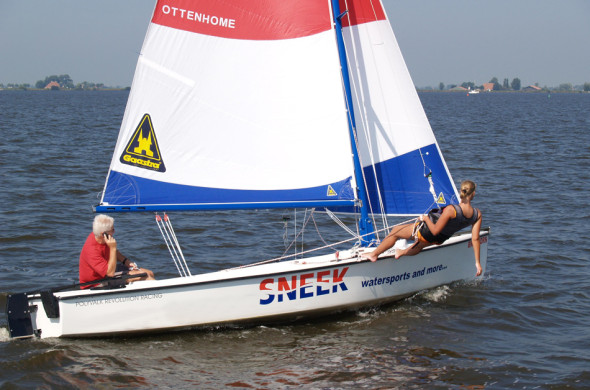The newest Polyvalk model was launched in 2004. It signalled a revolution in the open-boat market: The Polyvalk Revolution.
The Polyvalk Revolution cannot be capsized. On more open water in particular, such as the larger Frisian Lakes, the IJsselmeer and the Zeeland waterways, this boat offers high levels of safety and reliability in addition to perfect sailing characteristics.
| Length | 6,65 mtr. |
| Width | 2,00 mtr. |
| Ballast | 575 kg. |
| Sail area | |
| Mainsail | 12 m2 |
| Jib | 5,5 m2 |
| Height | |
| Upright mast | 6,50 mtr. |
| Lowered mast | 1,00 mtr. |
| Mast on crutch | 1,50 mtr. |
Polyvalk Revolution according to CE standard €16,475
• Completely new design of deck and cockpit, as described
• Rigid, modern hull with sandwich structure, modern Sprenger Racing fittings
• Self-levelling thanks to new design, cannot capsize and drains water very quickly.
• Self-draining cockpit in accordance with CE standards
• Colour: standard in white or sand, other colours on request
• All-round PVC rubbing strake
• Aluminium mast, pole and gaff
• Mainsail with double reefing system 12 m²
• Deck blocks with sheet cleats
• Genoa carriage with rails for jib sheet
• Halyards and topping lift cupsheet on pin rail
• Black polypropylene mooring lines
• Bisonyl sail cover, colour of choice
• 100% synthetic interior, colour of choice
• Stern-mounted rudder or quarter rudder
• Hull, deck and cockpit in colours of your choice
• Sprenger stainless steel fittings
• Cast-iron keel with 2-component epoxy layer
• Draft 0,85 m
• Synthetic motor shelf
• Full boat inventory

The familiar Polyvalk Classic is built up out of three separate parts, namely the hull, deck and cockpit. In the Revolution, on the other hand, the cockpit, front cabin and rear cabin are integrated into the deck. As a result, the inside of the hull is completely free of laminated parts, and is built using the well-known and very stiff sandwich construction. A stiffer boat is better at transferring wind energy into movement forward through the water. It can be felt in the speed of the yacht and the way it reacts to waves. In a manner of speaking, the Revolution tends to ‘drive its way’ through rather than pitch up and down. The result is better sailing and steering response.
A major advantage of this method of construction is that there are much larger air boxes under the gunwale and the front and rear cabins. These are so large that the upward force is enough to give the boat a 130° angle. This means if you push the masthead one metre under water, the boat will still stay return upright rapidly and be able to continue sailing in a stable manner.
It means the Polyvalk Revolution cannot be capsized. On more open water in particular, such as the larger Frisian Lakes, the IJsselmeer and the Zeeland waterways, this boat offers high levels of safety and reliability in addition to perfect sailing characteristics.